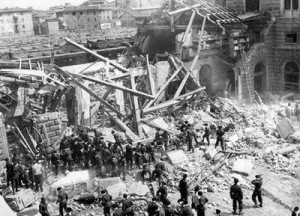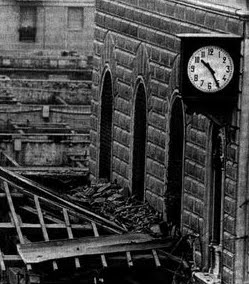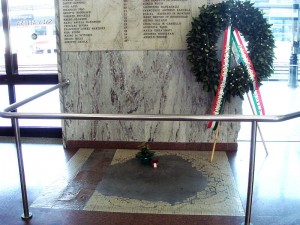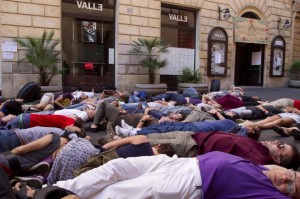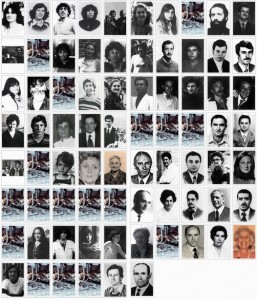Remembering Bologna January 23, 2012
Author: Beach Combing | in : Contemporary , trackbackBeachcombing doesn’t normally have much time for railway-stations, but for Bologna he’ll make an exception. It is not the edifice itself that catches his attention, but the way memory has been built into its very fabric: the memory that is of 2 August 1980.
At 10.25 on the morning of that day a bomb went off in the waiting room, in a station crowded with holiday-goers: eighty five were killed and over two hundred wounded. No other terrorist attack on Europe soil before the Islamism of the 2000s came close to this. The bomb blast would have been bad enough, but it was placed in such a way that the roof came down killing scores more than would otherwise have perished.
The question of who actually planted the bomb is a long and involved one and a common opinion is that those serving prison sentences might not necessarily be the guilty parties. Sufficient to say that this was probably an extreme right-wing attack and that there may have been some involvement on the part of state agencies either – horror of horrors – in the planning or, more credibly, in covering up afterwards. This, at least, is the considered opinion of the Italian judiciary. In Italy you don’t need to be a conspiracy nut to believe in conspiracies: it is a mainstream activity.
Terrorist attacks are not really bizarre history territory – though we previously visited Omagh, but as Beach hinted above there is something eerie about the memory of the bomb attack in the building: the Italians have the aesthetics of commemoration down to a fine art.
For one, the clock in Bologna station stands permanently at 10.25, the minute the bomb went off. It must have taken some courage for the public authorities – at a station of all places! – to insist that the clock be left unfixed. How many German tourists are misled every year we wonder.
There is a plinth with the names of the victims just above the place where the bomb was positioned: look at the scorch marks on the photograph. The words on the plinth record a ‘fascist atrocity’: something particularly meaningful in red Bologna.
Then the Bolognesi, a people famed for their creativity, have built the memory of the attack into their yearly calendar with demonstrations and rituals. Here is one particularly novel attempt to recall the dead with the living.
Beach stumbled on this extraordinary video too – *!mature content!* – of a young cameraman who was first on the scene and who somehow managed to record the carnage around him without his hand shaking too much. Over the top in the audio track any reader who knows Italian will be able to hear the mounting horror of the Bolgnese ambulance crews as they realise what they are dealing with: ‘tell everyone, we need blood donors…’
Finally, a picture that encompasses it all. One bomb, one moment in time: eighty five senseless deaths.
Any other buildings with scars? Drbeachcombing AT yahoo DOT com
***
24/Jan 2012. Umbriel has some nice examples here: ‘Regarding your recent post on Bologna Station — There are, of course, major building preservations of bomb damage from WWII. The ruins of the Kaiser Wilhelm Memorial Church and the Hiroshima Prefectural Industrial Promotion Hall have both been preserved as war memorials. A couple of my examples of my own experience, however, seem closer to what your post had in mind. The J.P. Morgan Building on Wall Street (a stone’s throw from the World Trade Center site, as most things in downtown Manhattan are) still bears shrapnel scars from the anarchist bomb detonated in front of it in 1920, as shown in this article. Another scarred former train station is Kansas City, MO ‘s Union Station (now a civic and shopping center) the facade of which bears bullet scars from an attempt by ’30s gangster Pretty Boy Floyd to rescue one of his gang members from Federal custody (as referenced in this old New York Times article about the plans to redevelop the disused station, bullet holes unfortunately not pictured)‘ Then Southern Man: ‘You forgot the most beautiful of all the preserved ruins: the blitzed and roofless Coventry Cathedral. ‘May God forgive us all’! Thanks Southern Man and Umbriel!
28/1/12: Ricardo writes: Your post on Bologna reminded me immediately of a project a friend of mine is working on, about the Portuguese massacre of Mueda, in Mozambique. This was in the beginning of the our modern African wars and, since Mozambique independence to some years ago, this massacre was re-enacted by the locals. The is a film, called Mueda, by director Ruy Guerra that documents one such re-enactment. And a link to my friends project, about the manipulation of archives and memories [in Portuguese but well worth the read]. Then Mike weighs in with some lovely London examples. Beach particularly enjoys the last: 1) the west-facing wall of Stone Buildings in Lincoln’s Inn – heavily scarred with bomb shrapnel from WWII; 2) the wall of Bart’s Hospital in Smithfield next to the Wallace Memorial – ditto; 3) the North East end of St Clement Danes Church facing the Royal Courts of Justice – ditto; and a slightly relevant anecdote. A director of Ercol Furniture told me that years ago they bought up a number of trunks of lime trees that had been removed from the Mall in London because of disease etc, hoping to produce a limited edition run of furniture from those trees. Apparently the quantity of shrapnel embedded in the wood played havoc with the saws that Ercol used to cut them up.’ Then Charlotte Frost via Twitter ‘Tanks chipped wall and kerb stones in Havant, Hants during WWII. Under ‘Bombed out’ Thanks Ricardo, Charlotte and Mike!
3 Feb 2012: GT sends in this memory of Gettysburg: ‘You might be interested in this link that shows some damage to a building in Carlisle, Pennsylvania, sustained in the Gettysburg Campaign.’ Thanks GT!! Then Ricardo with the Carmo Convent: It remains as a testimony to the big Lisbon earthquake of 1755, which rippled accross Europe, affecting science, culture and arts (Voltaire even wrote a book related to it, “Candide”). Thanks Ricardo and GT!!

